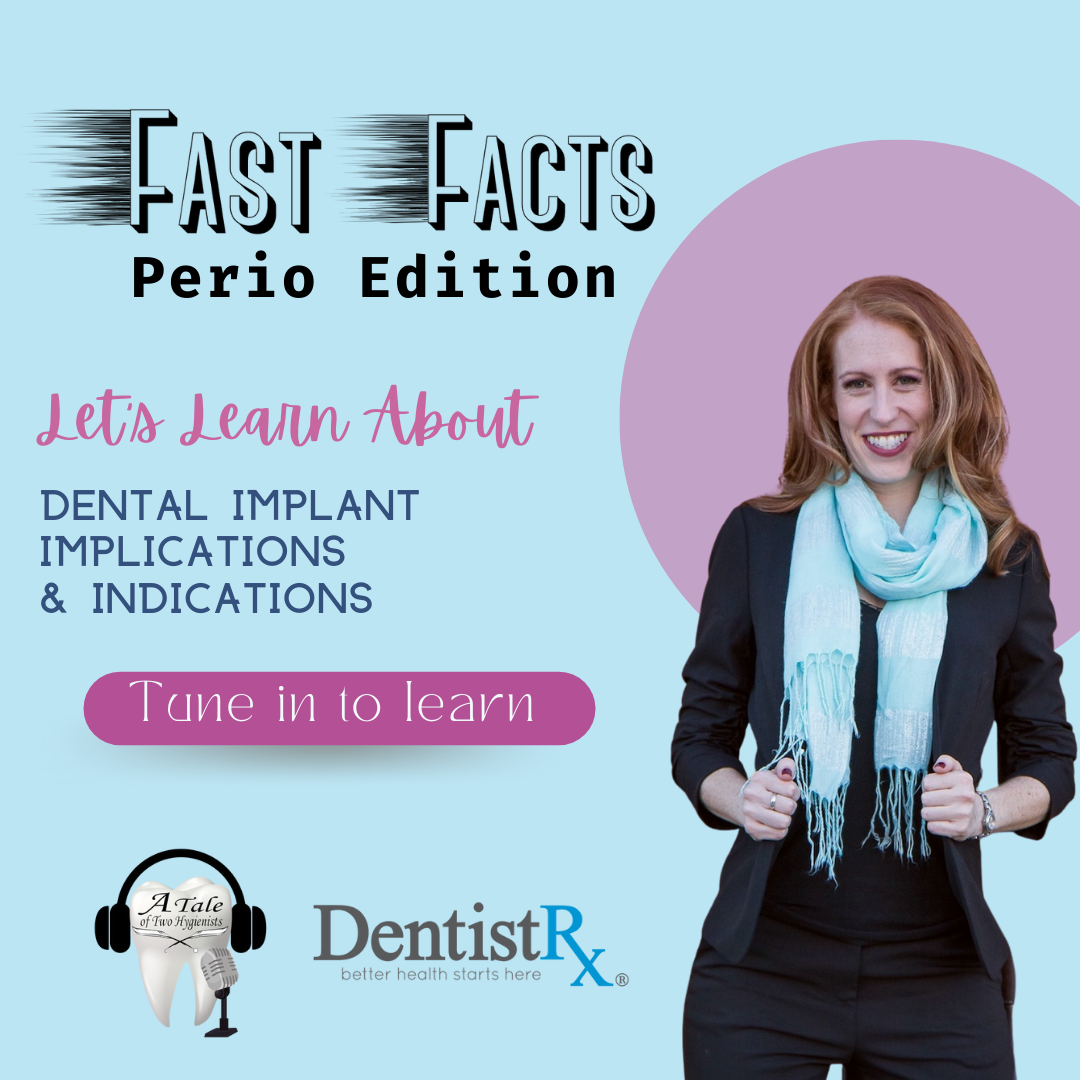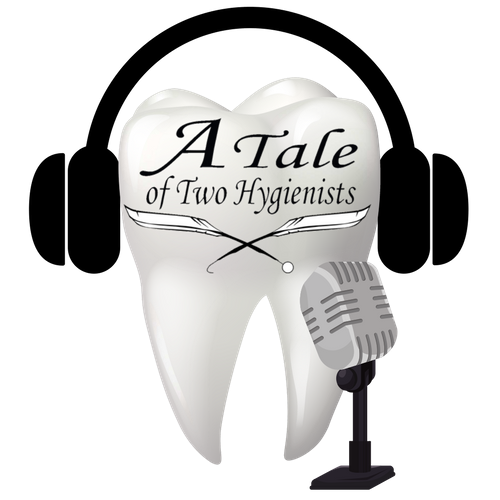
Fast Facts: Perio Edition Episode 79
[Andrew Johnston, RDH]
Welcome back everyone! You are listening to another episode of Fast Facts- Perio Edition brought to you by A Tale of Two Hygienists in partnership with DentistRX. And now, please welcome your host, Katrina Sanders.
[Katrina Sanders, RDH]
Hello, and welcome to Fast Facts Perio Edition. This week we are talking about dental implant implications and indications. Essentially, why is it that you would decide to encourage a patient to move into a dental implant versus other tooth replacement options? I'm going to begin this episode by sharing a slightly provocative idea, and that idea is, I think many of us in the dental profession have viewed dental implants as the more expensive option when it comes to tooth replacement. And perhaps for a long time that was true. However, as we begin to look at the implications of why we would place a dental implant, it certainly changes the indications around why a dental implant may be your optimal choice to begin with. And respectfully, perhaps in some of these cases, in the long run, the dental implant might actually be the more cost effective option. So let's begin by looking at some of the most common indications for the placement of a dental implant. When we're talking about the placement of a dental implant, we're oftentimes, of course, exploring tooth replacement. But when we talk about implications, it's important for us to know why we're replacing those teeth.
So, for example, we could be placing a dental implant simply because there is a congenitally missing tooth. If you've got a young patient who is congenitally missing a tooth, ultimately a dental implant is going to be the more optimal long term solution so as to reduce the challenges associated with needing to cut into otherwise healthy adjacent teeth. But if we're looking at broken or fractured teeth, we need to look at 'do these teeth experience significant loss of tooth structure?', so more than the tooth structure is lost or are they presenting with significant caries? You see, when we're talking about an individual who has significant decay or even has a high caries index, this could theoretically perhaps be somebody who has systemic disease in which there is a dramatic impact on salivary flow and then of course, an increase in caries regimens. So when we take a look at these types of patients, we know that dental implants absolutely are an option, but so are options like a fixed prosthetic device, like a bridge or maybe a partial denture. The challenge being when we're looking at these particular patients, the patients who have a high caries index, have a high prevalence of decay and require a caries management regimen. When we look at their CAMBRA, their caries management by risk assessment, we know that these are individuals where if we are now leveraging adjacent teeth, we are now cutting into adjacent teeth that for all intents of this conversation, might already have a restoration in there. Might already have a need for a restoration in there. If we're cutting into another tooth, we are now leveraging hard tissue. We are now expecting that these abutment teeth are either going to be able to effectively support a bridge or are going to be able to effectively support a partial denture in which clasps could be seen as a caries retentive, a plaque retentive factor. Or in many cases I implore you to consider, if this patient has high caries rate, has significant tooth structure loss because of decay, has a high decay rate because of low salivary flow, high cariogenic diet, gerd or acid reflux, maybe an eating disorder etc. These are individuals who are in a constant acidic state. Are these individuals that we can readily trust that the abutment teeth are going to be able to sustain long term? Does placing a bridge give us a more inexpensive option to be able to provide some tooth replacement opportunities. However, long term will this abutment the teeth sustain? Or are we essentially creating a snowball effect of the challenge?
We also need to look at other options. We're certainly also going to be placing dental implants in sites where perhaps there has been a periapical radiolucency, localized issues of an endo perio lesion. A large post in the period space we call a large post placed into a root canal therapy as a future implant site. Because oftentimes large posts we know can compromise the integrity of the tooth structure and may eventually lead to broken or fracturing of the teeth.
Finally, we have the opportunity to explore the reasons why periodontal disease will leverage the need for dental implants. This could be, of course, bone loss into a fraction site, tooth mobility, infection, or abscess of the periodontium, and this could even be sites of localized vertical bone loss. In these cases, we always want to make sure that we are controlling the sequelae of periodontal disease before loading a dental implant.
Thank you so much for joining me this week. As we discussed a Fast Fact around why it's important for us to not only look at an indication, but the implications for why a dental implant would need to be placed in a dental patient's mouth.
This has been another episode of Fast Facts - Perio Edition with Katrina Sanders, RDH. Please feel free to reach me on Instagram @thedentalwinegenist or on my website www.KatrinaSanders.com Cheers.
[Andrew Johnston, RDH]
Thank you for listening to another episode of Fast Facts - Perio Edition, brought to you in part by DentistRX makers of the InteliSonic line of power brushes. Find out more by visiting their website at www.dentistrx.com. We'll see you next week for another Fast Fact!
Resource:
Gómez-de Diego, R., Romero-Pérez, M. J., Cutando-Soriano, A., & López-Valverde-Centeno, A. (2014). Indications and contraindications of dental implants in medically compromised patients: update. Medicina oral, patologia oral y cirugia bucal, 19(5), €483
